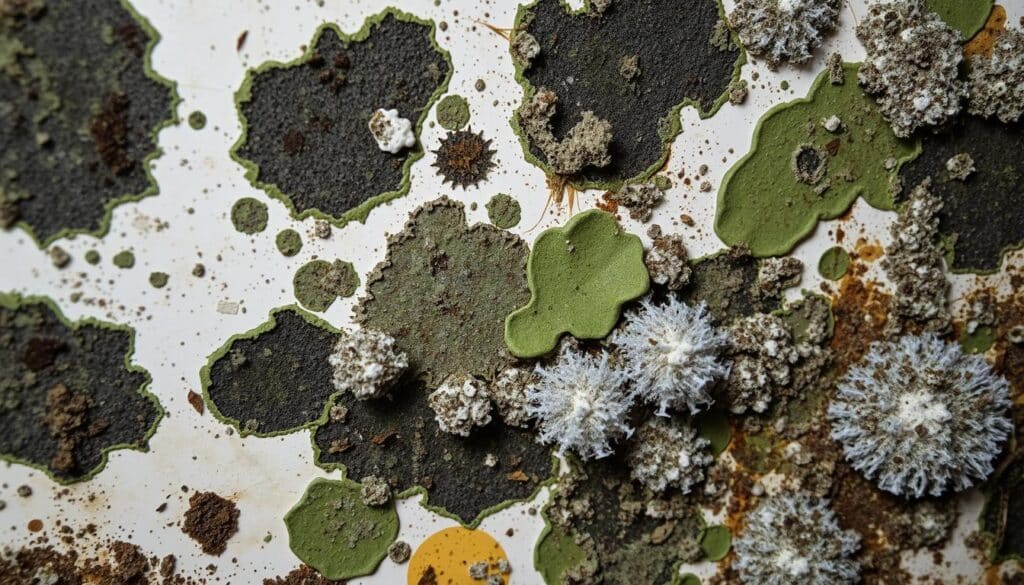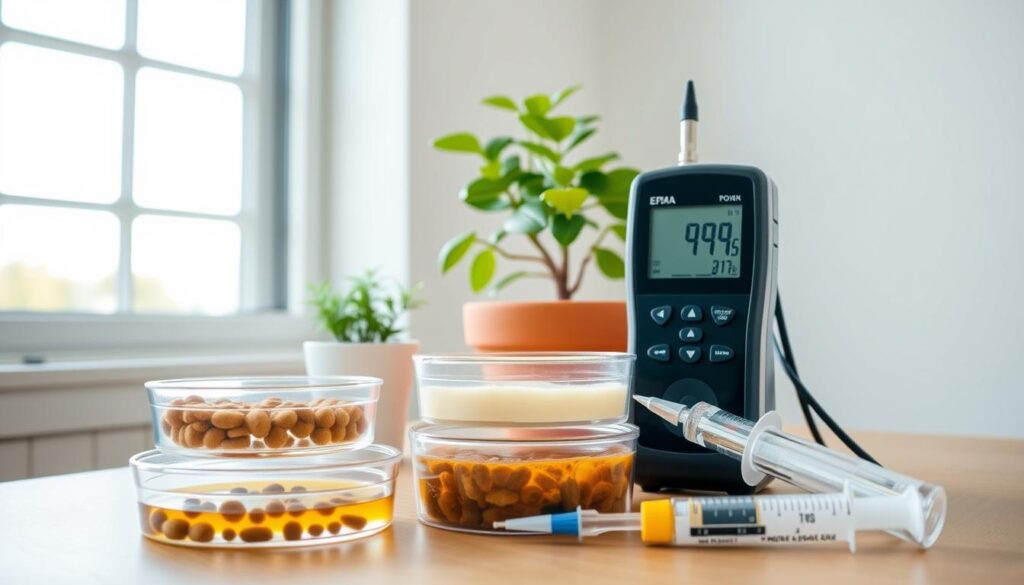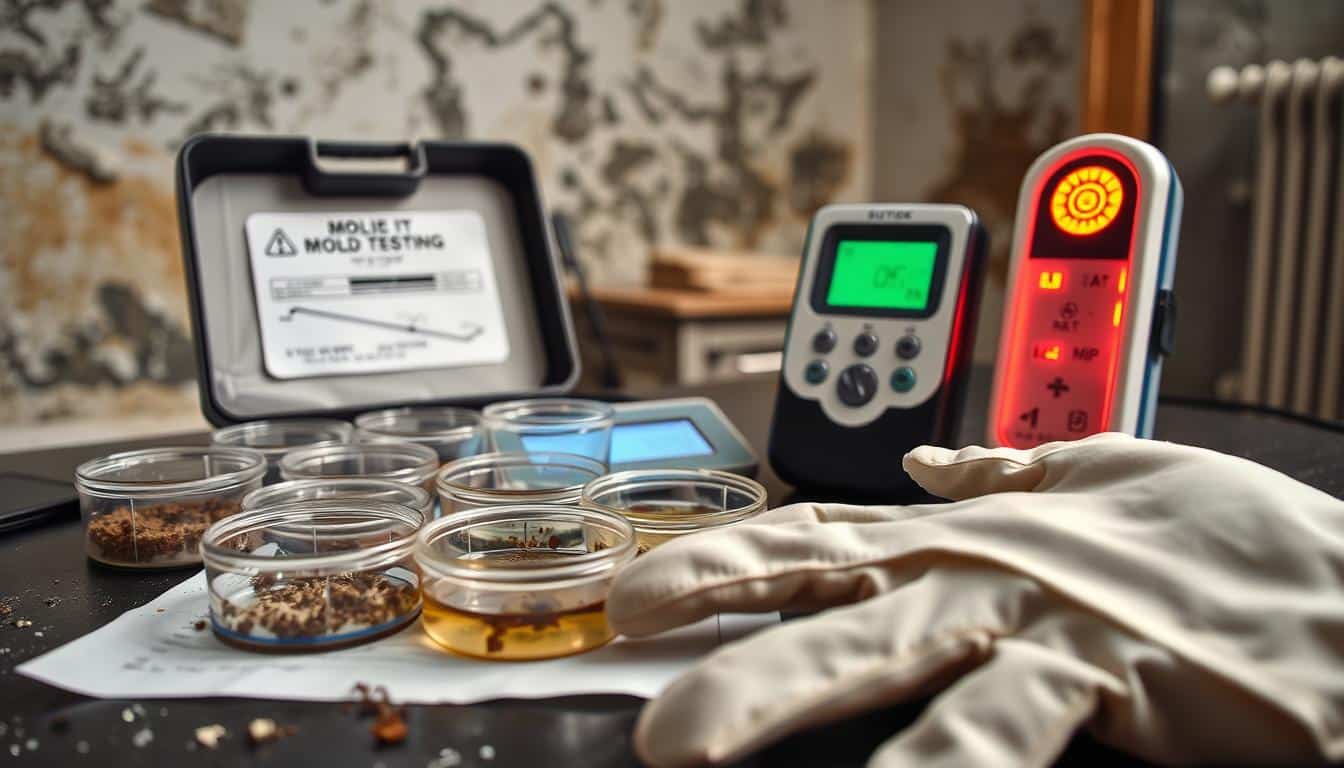Did you know indoor air pollution can be up to five times worse than outdoor air? This is a shocking fact that shows how vital it is to check your air quality for mold. Mold spores can spread easily in the air, which is dangerous for your health and your family’s. It’s key to know how to test your home’s air quality and fix any mold problems fast.
Mold-testing kits are easy to find in home improvement stores and online. They help homeowners check their indoor air quality. These kits have disks with a special culture that can spot mold spores. But, it’s important to follow the instructions and let the kit sit untouched for at least 48 hours for accurate results.
Mold likes places with moisture, warmth, and darkness. So, it’s important to watch out for these areas in your home. While a DIY mold-testing kit can give you useful info, it’s best to get a professional mold remediation specialist to handle any mold safely and well.
Key Takeaways
- Indoor air quality can be up to five times worse than outdoor air, highlighting the importance of mold testing.
- Mold-testing kits are widely available and can help homeowners detect the presence of mold spores in their homes.
- Mold thrives in high-moisture, warm, and dark environments, so it’s crucial to inspect your home for potential problem areas.
- Professional mold remediation services are recommended to safely and effectively address any mold issues in your home.
- Proper air quality testing and mold inspection are essential for maintaining a healthy, mold-free living environment.
Understanding the Importance of Mold Testing
Mold is everywhere, inside and outside. But when it grows indoors, it’s a big health risk. Indoor air can be up to five times more polluted than outside air. Mold is hard to spot, and finding where it starts is tricky.
Mold spores can float in the air, threatening our health.
Health Risks of Mold Exposure
Being around mold can cause many health problems. These include coughing, wheezing, and stuffy noses. It can also lead to allergic reactions, headaches, and feeling tired or sick.
Some molds make harmful toxins. These toxins can make symptoms worse. It’s key to stop mold from growing and fix it fast to keep us healthy and safe.
The Need for Early Detection
Mold can spread quickly, in just 24 to 48 hours. Mold testing is a must if you see mold or high moisture. It shows how bad the problem is and what kind of mold it is.
Doing detailed checks and air quality tests helps. These tests give a clear picture of the mold problem. This lets experts fix it right.
“Mold can grow and spread in as little as 24 to 48 hours, highlighting the importance of early detection and prompt action.”
Knowing the dangers of mold and the need to find it early helps us stay safe indoors. We should watch for moisture, act fast, and get help from mold experts. These steps help keep our homes healthy and free from mold harm.
Signs of Potential Mold Infestation
It’s important to spot the signs of mold early. One clear sign is visible mold growth on walls or ceilings. Mold can look like black, green, or brown spots. It might also have a fuzzy texture.
Peeling or discolored paint or wallpaper is another clue. These signs suggest mold might be present.
Visible Mold Growth Indicators
- Discolored or stained surfaces in green, black, blue, brown, orange, grey, or white
- Fuzzy or velvety textured growth on walls, ceilings, or other areas
- Peeling or discolored paint or wallpaper
A musty smell is another sign of mold, even if you can’t see it. This smell can mean mold is hiding in walls or floors. Water damage, like stains or warped surfaces, also points to mold.
Musty Odors and Water Damage
- Persistent musty or earthy odor, even without visible mold growth
- Water stains, warped surfaces, or other signs of moisture intrusion
- Discolored or damaged flooring, walls, or ceilings due to water exposure
Spotting these signs is the first step to fixing the problem. Taking action quickly and getting a mold test can help solve the issue. This keeps your home healthy and safe.

“Mold colonies often grow in tile grouts in bathrooms due to poor ventilation, leaky toilets, and damp cellulose materials.”
DIY Mold Testing Kits
To find mold at home, you can use a mold-testing kit. These kits are easy to find in stores and online. They come with special disks that help mold grow, so you can test it.
When using these kits, make sure to follow the instructions. Close all doors and windows a day before testing. Also, don’t touch the dish for the time it says on the kit.
Types of Mold Testing Kits
There are three ways to test for mold with DIY kits. You can test the air, the heating and cooling system, or the surfaces. The surface test can tell you what kind of mold you have in about three weeks.
The time it takes to see mold growth varies. You might see results at 48, 72, or 96 hours.
Advantages and Limitations of DIY Testing
DIY kits are a good start, but they have their limits. The EPA doesn’t recommend any specific kit. If you’re really worried about mold, it’s best to get a professional to check.
Getting your mold samples checked by a lab costs $40.00. You’ll get the results in about three weeks. These kits can find mold spores in the air or on surfaces. But, if you keep feeling sick, you might need a mold expert.
| Mold Test Kit | Features | Limitations |
|---|---|---|
| Seeml Labs DIY Mold Test Kit | Includes analysis fees for three samples, offers expert consultation, suitable for surface testing | Requires samples to be mailed for lab analysis |
| My Mold Detective MMD103 Mold Test Kit | Designed for air testing, requires payment of a testing fee for each sample sent for professional laboratory evaluation | Samples must be taken close to the original mold growth to reduce the risk of false negative results |
| Airthings Indoor Air Quality Monitoring System | Helps monitor home conditions conducive to mold growth, including humidity, temperature, radon levels, and VOCs | Does not directly test for the presence of mold, only provides alerts on mold-conducive conditions |
In conclusion, DIY mold testing kits are useful but have their limits. The EPA and CDC suggest getting a professional check. Always follow the kit’s instructions, think about the lab analysis cost, and be ready to see a mold expert if needed.
How to Test Air Quality for Mold
Step-by-Step Guide
Ensuring a safe and healthy indoor environment starts with understanding how to properly test for mold. First, invest in a quality mold testing kit, like the Air Check Mold Testing Kit. It can accurately identify over 20 types of mold spores, pollen, and dust. This kit includes two free test cassettes, with the option to order more as needed.
To get an accurate mold assessment, order one cassette for each floor and an outside control sample. For larger areas, use one cassette per 1,000 square feet. If there’s water damage or visible mold, take additional tests in those areas.
Best Practices for Accurate Results
Once you have your testing kit, prepare the room by closing doors and windows at least 24 hours before the test. This helps concentrate mold spores in the air, making them easier to detect. Next, remove the lid from the petri dish and place it on a flat surface, leaving it untouched for the test, usually 48 hours. During this time, restrict traffic in the room to avoid disturbing the air.
After the waiting period, seal the petri dish and store it in a dark space for at least two days to allow any mold present to grow. If mold is detected, you can then send the sample to a lab for further analysis to determine the specific types of mold. The Air Check Mold Testing Kit includes laboratory fees for the complete analysis of both non-toxic and toxic mold.
By following these step-by-step instructions and best practices, you can effectively test for mold in your home and take the necessary steps to maintain a healthy indoor air quality.

Interpreting Mold Test Results
When you get mold test results, they might seem confusing at first. But, understanding them can tell you a lot about your home’s air quality. Let’s look at how to make sense of mold test results and what they mean for your home.
The results will show you which molds are present and how much of each. Common molds in homes include Penicillium/Aspergillus, Cladosporium, and Stachybotrys. Each mold has its own traits and health risks.
| Mold Type | Characteristics |
|---|---|
| Penicillium/Aspergillus | The most common mold species found indoors and outdoors. Most sub-species are allergenic, with a few being toxic. |
| Cladosporium | Frequently found both indoors and outdoors, with levels varying based on activity, weather, and air exchange rates. |
| Stachybotrys | The most common toxic mold species, rarely found indoors. Elevated levels indicate a potential indoor problem. |
The results will also show mold spore counts. This is measured in spores per cubic meter (spores/m³) of air. Here’s how to understand these numbers:
- 0-50 spores/m³: Trace levels, not an issue, considered extremely clean.
- 51-500 spores/m³: Very low levels, still considered extremely clean.
- 501-1500 spores/m³: Low levels, acceptably clean; Penicillium/Aspergillus and Cladosporium spore concentrations can be normal at this level.
- 1501-3000 spores/m³: Moderate levels, may indicate an indoor reservoir, requiring comparison to exterior control samples.
- 3001-4500 spores/m³: Slightly elevated levels, may require cleanup if corresponding concentration is not found in exterior control samples.
- 4501-10,000 spores/m³: Moderate to high concentrations, often requiring cleanup actions and potential identification of hidden fungal growth.
- 10,001-25,000 spores/m³: High mold concentration levels, necessitating cleanup efforts and indicating potential large fungal growth areas.
Understanding mold test results is key to knowing what to do next. If the results show high mold levels, finding and fixing the cause is crucial. This might mean fixing moisture issues or water damage. Sometimes, you’ll need a professional mold inspector to help fully assess and fix the problem.
When to Hire a Professional Mold Inspector
Dealing with mold in your home can be scary. Knowing when to call a professional mold inspector is key. [https://www.moldremediatorsusa.com/are-home-mold-test-kits-reliable-expert-insights/] Home test kits might seem easy, but they often give wrong results. A professional mold inspection is better for checking your home’s air and health.
Benefits of Professional Inspections
Certified mold inspectors have the skills and tools to find and fix mold problems. They can spot hidden mold, find the cause, and give you a detailed plan for fixing it. This expertise is vital for solving mold issues and stopping them from coming back.
Here are some times when you should get a professional mold inspector:
- Visible mold in your home
- Water damage or moisture problems
- Unexplained health issues that might be from mold
- Before buying or selling a house
- As a preventive step, especially in humid areas
Getting a mold inspection might cost more than DIY kits. But, a pro’s thorough check can save you from expensive and dangerous mold problems later.
“Certified mold inspectors have the knowledge, tools, and give a detailed report. They help fix mold problems and suggest how to prevent them.”
| Mold Issue | Recommended Action |
|---|---|
| Visible mold growth | Hire a professional mold inspector |
| Water damage or moisture issues | Hire a professional mold inspector |
| Health concerns linked to mold exposure | Hire a professional mold inspector |
| Before buying or selling a property | Hire a professional mold inspector |
| Preventive measure in humid climates | Hire a professional mold inspector |
Mold Remediation and Prevention
Dealing with mold needs a two-step plan: find and fix the cause, and get help from mold removal experts. First, find and fix the moisture problem that let mold grow. This might mean fixing leaks, better ventilation, or controlling humidity. Keeping moisture in check is key to stop mold from coming back.
For big mold problems or mold in hard-to-reach spots, call a professional mold removal service. They have the right tools, training, and know-how to safely remove mold. They also know how to get rid of moldy stuff and stop mold from coming back. This is important for keeping people healthy and the building safe.
Addressing the Root Cause
Mold loves warm, damp places, so fixing the cause is vital. This means fixing leaks, better air flow, and keeping humidity down. By fixing these moisture issues, you can stop mold from coming back and make your indoor space healthier.
Professional Mold Removal Services
For big mold problems or mold in hard spots, get a pro mold removal service. They have the right tools, training, and know-how to safely remove mold. They also know how to get rid of moldy stuff and stop mold from coming back. This is important for keeping people healthy and the building safe.
| Mold Remediation Considerations | Explanation |
|---|---|
| Identify and address moisture sources | Controlling moisture is crucial in preventing future mold growth. |
| Safely remove and dispose of contaminated materials | Proper containment and disposal of moldy materials is essential to prevent the spread of mold spores. |
| Implement measures to prevent future mold growth | Professionals can recommend and implement long-term solutions to maintain a mold-free environment. |
“Addressing the root cause of mold is critical for ensuring a healthy indoor environment and preventing future infestations.”
Maintaining a Mold-Free Environment
Keeping your home mold-free is key to your health and home’s safety. Focus on moisture control and regular monitoring and inspection to do this.
Moisture Control Strategies
Mold loves damp, humid places. So, controlling moisture is your first defense. Fix leaks, ensure good ventilation, and use dehumidifiers if needed. This stops mold and makes your home healthier.
Regular Monitoring and Inspection
Check your home often, especially where moisture can build up. This helps catch mold early. You can do DIY mold tests or get a professional mold inspector. Being proactive keeps your air clean and your home safe.
| Mold Prevention Strategies | Benefits |
|---|---|
| Moisture Control | Addresses the root cause of mold growth by regulating humidity and preventing water intrusion |
| Regular Monitoring and Inspection | Helps identify and address mold issues early, preventing further spread and damage |
| Professional Mold Inspection | Provides expert assessment and recommendations for effective mold remediation and prevention |
Using these methods, you can keep your home mold-free. This makes your living space healthy, safe, and comfy. Always be ready to prevent mold to protect your home and health.
Common Types of Mold Found Indoors
There are thousands of mold species, but some are more common indoors. Mucormycetes, Alternaria, and Aspergillus are among them. Mucormycetes are found in soil, especially in summer and fall, and are usually harmless.
Alternaria alternata causes allergies and can spread quickly indoors. Aspergillus grows on surfaces, especially in moist areas. It’s a common mold found in many homes.
While “toxic mold” or “black mold” (Stachybotrys chartarum) is rare, any mold can be harmful if not treated. Identifying and removing mold is key to a healthy home. Knowing the common molds and acting fast helps keep our homes safe and comfortable.
Being alert to mold is crucial for our health. Knowing about indoor mold and its dangers helps us prevent it. This way, we can keep our homes mold-free and protect our families.
FAQ
What are the signs of potential mold infestation in a home?
Look out for black, green, or brown spots on walls and ceilings. A fuzzy texture is another sign. Musty smells can also mean mold is around, even if you can’t see it.
Water damage like stains or warped surfaces might also point to mold.
How can I test the air quality for mold in my home?
Use a mold-testing kit from a home-improvement store or online. These kits have special disks that grow mold. Follow the instructions carefully and keep the area closed before testing.
What should I do if the mold test kit shows signs of mold growth?
If the kit shows mold, send the sample to a lab for a detailed analysis. This will tell you what kind of mold it is. Even without visible mold, a musty smell could mean mold is there. In this case, get a professional mold inspector for a thorough check.
When should I hire a professional mold inspector?
Get a certified mold inspector if you see mold, have water damage, or health issues. They’re also good before buying or selling a house. This is especially true in humid areas.
How can I maintain a mold-free environment in my home?
Keep moisture levels down by fixing leaks and using dehumidifiers. Regular checks for moisture can catch mold early. This helps prevent bigger problems.
What are some of the most common types of mold found indoors?
Common indoor molds include Mucormycetes, Alternaria, and Aspergillus. “Toxic mold” or “black mold” is rare but any mold can be harmful. It’s important to identify and clean up mold to keep your home healthy.




